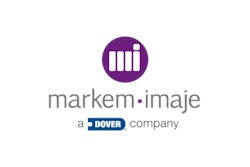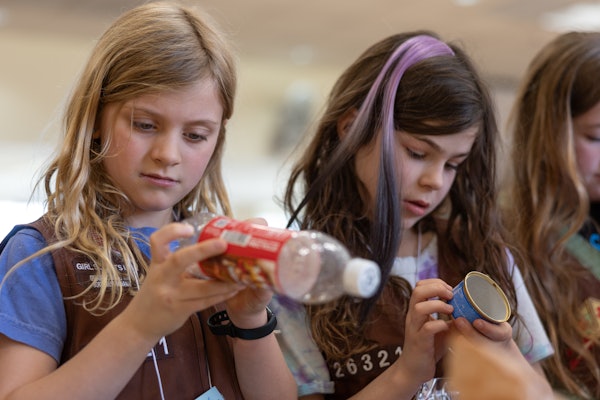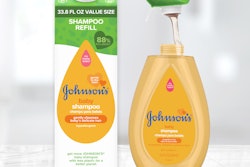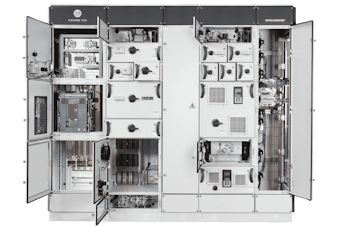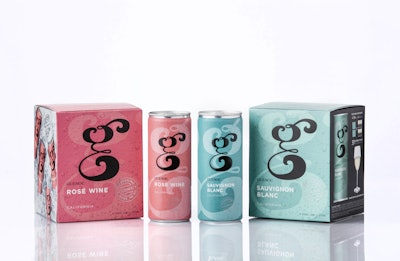
When co-packer Free Flow Wines of Napa, CA, installed an entry-level wine canning line in April 2017, the idea was to dip its toes in the water to test the market. But by late July 2017, when Contract Packaging magazine visited the plant, Free Flow was wishing it had jumped in feet first, given the extraordinary demand for its services.
“In the world of being a CEO, you wish you had a crystal ball so you could clearly see what things look like a year down the road, because it would be a lot easier to plan,” says Jordan Kivelstadt, co-founder and CEO of Free Flow Wines. “But we don’t have that. When I made the request to the board in August 2016 to install a wine canning line, cans had just taken their first little surge forward, but there still wasn’t a lot of product on the market. We only had a few customers banging our door down to can their wines right then and there. But we’ve just seen that grow, grow, grow. The response we’ve seen from the industry has been astounding. We're just scrambling to keep up.”
Launched in 2009 by Kivelstadt and Don Donahoe, Free Flow is a turnkey supplier of wine kegging services. When customers began inquiring about wine canning however, the company took a serious look at entering the market. As Free Flow Director of Operations Rob Perman explains, wine canning is an underserved market. “We saw it not only as a niche we could serve, but also as a way to diversify our revenue stream, especially to offset some of our slower months on the kegging side.”
And, as they say, once they built it—a 50-can/min line featuring a counter pressure filler, a full-body sleeve labeler, and a shrink wrapper—the customers came. Among them, Foley Family Wines, based in Santa Rosa, CA, which introduced its Guenoc brand in a can, and Essentially Geared Wine Co. of Napa, CA, a company launched solely to produce wine in a can under the Essentially Geared name.
Wine market ripe for cans
At year-end, June 2012, wine in a can was a $1.9 million industry. By 2016, Nielsen reported that sales of canned wine had grown to $14.5 million, up 125% from 2015. In 2017, the market is estimated to be worth $35 to $40 million.
When founding Essentially Geared in mid-2016, Grant Hemingway and partner Kivelstadt saw the trend of craft beer and craft sprits moving to aluminum, spearheaded by younger consumers. “We felt the market was ripe for the can format for wine, given the rise in Millennial consumption and purchasing power, as well as the demand for convenience, outdoor consumption, and lifestyle brands.
“The core tenets of EGWC are Sustainably Packaged, Carefully Sourced, Always Essential. Cans are lightweight, durable, easy to open, and fully recyclable, and thus offer ultimate convenience in simple, resourceful packaging.
“Our primary differentiating factor in the market is wine quality. Real wine from quality grapes and solid winemaking used to craft an approachable, consumer-friendly profile, at an affordable price point.”
Essentially Geared, in three varieties—Chardonnay, Red Wine, and Rosé Wine—was introduced in May 2017 in 375-mL cans, sold singly or in a two-pack, held together with a PakTech can carrier. The wines are sold in 18 states at independent retailers, selected chain stores, and outdoor venues. “We intend to grow into 30 states in 2018 to meet increased demand and increased production,” says Hemingway.
For Foley Family Wines, established in 1996, the impetus to introduce one of its bottled wines in a can came from discussions with its partners and retailers, who saw the category growing. And what better brand to put in a can than its Guenoc, a wine marketed as “A Celebration of Independent Spirit.” Says Denise Roach, Director of Marketing for Foley Family Wines, “With this brand, we focus on an active lifestyle and outdoor living. It’s an adventure seeker’s brand, so that’s how we position it. The Guenoc brand includes really affordable wines that taste great and are made for everyone.”
Like Essentially Geared, Foley Family Wines is squarely focused on the quality of its wines. Its current portfolio includes a collection of brands from California, Washington, Oregon, and New Zealand. Explains Roach, Foley differentiates itself by having each property produce handmade, delicious wines that capture the character, varietal, and personality of the site.
Foley Family Wines introduced its Guenoc canned wine in May 2017, in Sauvignon Blanc and Rosé Wine. It chose a slim, 250-mL size, enough for a single serving, which it sells in four-count cartons; per law, 250-mL cans of wine cannot be sold singly. The wines are available in retailers nationwide, with increased distribution planned for 2018.
Free Flow’s starter line
As Essentially Geared and Foley Family Wines demonstrate, there was little time between Free Flow’s installation of the new packaging line and the commercialization of products coming off that line. But Free Flow was prepared, having carefully selected the equipment and having conducted a Factory Acceptance Test of the final line in Golden, CO, at the plant of its primary machinery supplier, Codi Manufacturing.
As Perman recounts, Free Flow met Codi at a Craft Brewers Conference, and after doing research and talking to some of Codi’s small manufacturing customers, it determined that Codi offered the technology it wanted in a size that fit their needs. According to Perman, Codi’s CCL-45 counter pressure filler offers a cleaner fill than open-air can filling, which was key for Free Flow.
“The machine actually closes on top of the can and keeps the pressure inside the vessel,” Perman explains. “It also helps us maintain the dissolved CO2 in the product better. Open-style can fillers fill from the bottom up, so if the wine or beer isn’t cold enough, it will start to spit out CO2 and foam.”
Free Flow also wanted a filler that could accommodate different can sizes. Currently it offers 375-mL and 250-mL cans; at some point, it plans to add a 187-mL size. Speed was not as much of an issue for the startup business. “We knew we weren’t going to have a high-capacity line,” Perman says. “The CCL-45 runs 40 to 50 cans per minute.”
Along with the filler, Codi also provided a depalletizer, a stainless-steel twist rinse, and some of the conveyors on the line. Codi’s semi-automated DPL-250 can depalletizer is manually fed with pallet loads of cans by operators and then uses a vacuum-style pick-up assembly in the pick arm to load cans into the twist rinse, and a vacuum assembly to pick slip sheets off the layers and stack them onto a pallet. The twist rinse trackwork, or cage, orients the aluminum cans into position upside down so the insides can be sprayed with ionized air to take the charge out of the cans and blow out any debris.
Another major piece of equipment on the line is an SL-10 shrink-sleeve labeler from Pack Leader USA. Free Flow added the machine to give customers an opportunity to test small runs of canned wines. Notes Perman, the minimums for printed cans are very high—around 110,000 for a 375-mL size and 130,000 for the 250-mL can, he estimates.
Foley Family Wines is one customer using full-body sleeve labels. Says Roach, “As we started looking at decorating, Ball is the company to work with if you’re going to print directly on cans. The issue we had was that their quantities were very high. It would require us to produce more than we wanted to, and we would also have to plan a good solid six months in advance.
“With this brand, it’s more of a just-in-time bottling, so we don’t necessarily know six months from now what we’re going to be doing. When we first put the product in the market, we needed to see how it performed before we could commit to another run.”
On the recommendation of Codi, Free Flow contacted Pack Leader to supply the sleeve labeler and shrink tunnel. Recalls Karl Lavender, Senior Vice President of Pack Leader, Free Flow was looking for a machine that could handle 187-, 250-, and 375-mL can sizes, while being easy to change over. Until that point, Lavender says, Pack Leader had not designed a machine for single-serve cans, so the challenge was to make sure they provided the right mandrel tooling.
The SL-10 can run at speeds over 100 cans/min, labeling packages before or after filling. It’s designed with the ability to be rolled up to a customer’s conveyor, or Pack Leader can provide the conveying equipment. In the case of Free Flow, Pack Leader provided the throughput conveyor to ensure no interruptions and to synchronize the speed of the cans moving through the machine. “If we provide the conveyor, everything is synchronized,” says Lavender. “If we’re cantilevering over onto a customer’s existing conveyor or onto an OEM’s conveyor, you lose the synchronicity of the equipment. So, as you turn up the speed of the machine, everything moves with it.”
While having a sleeve-labeling machine on the line is a great benefit for Free Flow’s customers, Perman says it adds a level of complexity to the process. It requires the packager, the label converter, and the machinery supplier to work in concert to ensure the label fits the machine’s tolerances. “We’re finding what materials work better than others, and we are working through it,” Perman says.
Additional equipment, services
Additional equipment for primary packaging of the cans includes a Markem-Imaje 9450 small-character ink-jet printer, which adds a date code to the bottom of the can right before it enters the filler; a Chart Industries UltraDoser 150S liquid nitrogen doser that adds a dollop of N2 during filling to eliminate oxygen in the headspace; and a lid dropper and seamer from Codi.
For those cans that receive a sleeve label, Free Flow supplies the brite stock cans and pull-tab lids from Ball. For its can, Foley Family Wines provides a full-body PETG label, flexo-printed in seven colors plus varnish, converted by CCL Label. As for secondary packaging, Free Flow can supply generic trays, if required. Essentially Geared uses preprinted cans, which it sources from Orora Packaging in Australia. “Ball is our primary contact, but we went through Orora to procure the 375-milliliter can, because of the lack of domestic production for this size,” explains Hemingway.
While the minimum for direct-print cans versus sleeves was a concern for Essentially Geared, Hemingway says the company wanted to take advantage of the advancements in printing capabilities. “The quality of graphics and overall aesthetic between print and sleeve is night and day,” he says.
Essentially Geared’s cans are printed in four colors, but a new design for a brand extension will fully utilize six-color process printing—“Think rainbow!,” Hemingway says.
Secondary packaging is labor-intensive
The least automated part of the Free Flow line is secondary packaging. For products such as Essentially Geared that use two-count can carriers, these must be manually applied; Free Flow can also apply four-pack can carriers. Tray packing is also manual: Operators first erect the corrugated trays, pack them with product—six four-pack cartons in the case of Foley Family Wines, and 12 two-packs for Essentially Geared—load the trays onto the infeed of a semi-automatic shrink bundler from EDL Packaging, press the start button, and then collect the wrapped trays at the outfeed of the shrink tunnel, placing them onto pallets by hand.
Initially the line did not include a shrink bundler. “We didn’t even know we needed it until everyone started asking us for it,” Perman says. “Luckily I was able to find a piece of equipment very quickly and install it. We didn’t even have the budget for it. So, we kind of learned as we went what people wanted.
“We really didn’t have any expectations for labor. We sort of had an idea of what we were going to need, but I think we underestimated it a little bit. The line is pretty labor-intensive. Some of the cost we have to eat, some we bill back to customers.”
As of late July 2016, Free Flow was conducting an analysis of its labor costs and the advantages of automating the secondary packaging process. Perman says automation could reduce labor on the line by four people “right off the bat.” To keep up with demand for canned wine, Kivelstadt says Free Flow plans to grow its capacity substantially over the next 18 months.
Consumers love convenience
While canned wine is still in its infancy, Free Flow and its customers agree that one of the biggest hurdles—convincing consumers of the quality of wine in a can—has already been mostly overcome. In fact, says Perman, Free Flow has struggled more with educating consumers about the quality of wine on tap.
“We struggled a lot with kegs, and I think we are still struggling more on the keg side than we are with cans,” Perman says. “The can is a fresh, new idea. It’s cool; you can take it to the beach, or camping, or boating. Even for people who say they don’t want to drink wine in a can, once they see the places they can take it, where they can’t bring bottles, they change their tune.”
Foley Family Wine’s Roach agrees: “People like convenience and portability. According to Nielsen, 73 percent of people say that packaging options that are easier to carry are important to them, and 90 percent of regular drinkers who plan to drink over the summer say they will drink wine outdoors.”
As for Essentially Geared, Hemingway says the company’s new product has generated “excitement and intrigue.” He adds, “The appreciation for the wine quality has been gratifying, but watching the consumer connect the dots, and understand they can now bring wine to places where it has been prohibited in the past is really rewarding.
“It’s a new era in wine consumption and purchasing habits, and quite honestly, it’s about time the wine industry displayed some innovation and creativity to engage consumers.”











